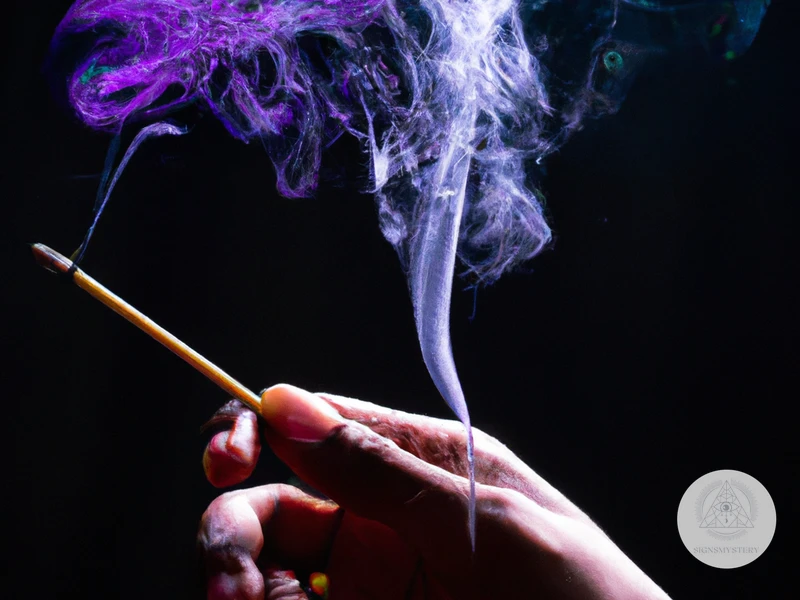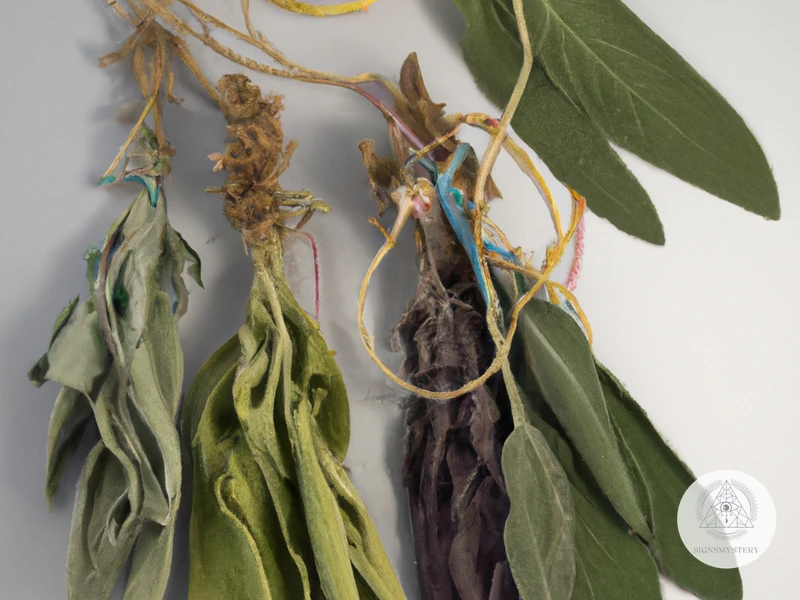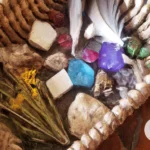Smudging with sage is a practice that has been passed down through generations and is deeply rooted in spiritual, cultural, and shamanic traditions. It involves burning dried sage, typically in bundles, and using the smoke to cleanse and purify people, spaces, and objects. The art of smudging with sage has gained popularity in recent times as people seek alternative ways to cleanse their homes and themselves of negative energy and promote healing. In this article, we will delve deeper into the origins of smudging, the benefits of smudging with sage, the types of sage used for smudging, and explore the art of smudging with sage in more detail. So, let’s explore this ancient and sacred practice together.
The Origins of Smudging

can be traced back to ancient civilizations, where the burning of sacred herbs and resins was used to cleanse and purify spaces or individuals. In shamanic traditions, smudging is a practice performed to banish negative energies or entities, balance and harmonize energy, and invite positive spirits or energies. Shamanic history shows that smudging was and still is used in different cultures and religions around the world, from the indigenous peoples of the Americas to the Far East. It is believed that smudging can bring clarity, enhance intuition, and promote healing, as well as offer protection from negative energies. The use of specific herbs, such as sage, cedar, and palo santo, also varies depending on the culture and purpose of the ritual.
Ancient Traditions
Smudging is an ancient tradition that dates back thousands of years. It is believed to have originated in ancient Egypt, where it was used in spiritual and medicinal practices. The ritual of burning herbs for purification purposes was also present in ancient Greece, Rome, and in many Indigenous cultures around the world. Smudging has been an integral part of shamanism and other spiritual practices for centuries.
In shamanism, the burning of herbs, specifically sage, is believed to cleanse negative energy and protect against evil spirits. It is also believed to connect the physical world with the spiritual world. Shamans will often use smudging before conducting healing rituals or receiving guidance from the spirit world.
Ancient traditions of smudging involved the use of a variety of herbs, each with its own unique properties. For example, sweetgrass was used by many Native American tribes for purification purposes, and is believed to bring positivity and good spirits. Mugwort was used in ancient Europe for divination and introspection purposes, and is believed to enhance psychic abilities.
Different cultures have their own unique smudging rituals and beliefs surrounding the practice. In Hinduism and Buddhism, incense is burned during prayers and meditation to create a peaceful environment. In traditional Chinese medicine, moxibustion, the burning of herbs, is used to treat various ailments.
The ancient practice of smudging has evolved over time and is still widely used today for spiritual, medicinal, and cultural purposes. It is a powerful tool for cleansing negative energy, improving mental and physical health, and connecting with the spiritual world.
Native American Practices
Native American practices of smudging with sage have been passed down through generations and hold a significant place in shamanism. The act of burning sage is considered a sacred ritual that is performed to purify and cleanse negative energy. It is believed that the smoke produced by the burning of sage carries prayers and intentions to the spirit world.
The use of Sage in Native American practices:
- In Native American practices, Sage is commonly used for cleansing and purification.
- The traditional practice involves burning dried sage bundles, also known as smudge sticks, to create smoke that is then used to cleanse spaces, people, and objects of negative energy.
- Sage has been used by many Native American tribes for a variety of purposes, including healing and spiritual practices.
- Its use in cleansing rituals stems from the belief that the smoke from burning sage carries prayers to the spirit world, and the scent of sage is believed to be purifying.
The significance of Smudging in Native American practices:
- Smudging with sage is considered a spiritual act that brings balance and peace to individuals, communities, and spaces.
- In Native American practices, it is believed that everything has a spirit and that smudging can help individuals connect with that spirit.
- It is believed that the smoke produced by sage can dispel negative energy and restore balance and harmony to the body, mind, and spirit.
- Smudging is also used in Native American practices as a way to honor ancestors and seek their guidance.
The traditional process of smudging:
- The traditional process of smudging involves preparing oneself and the space before lighting the sage bundle.
- The smudge stick is then lit and allowed to smolder while the smoke is fanned around the individuals, areas, or objects that need to be purified.
- The individual performing the smudging may recite prayers or intentions during the smudging process to help focus their energy and create a sacred space.
- After the smudging ritual is complete, the smudge stick is extinguished by placing it into a bowl of sand or a nearby ashtray.
Native American practices of smudging with sage involve a process that is deeply rooted in spiritual beliefs and traditions. It is a powerful ritual that is believed to help individuals find balance, peace, and connection with the spirit world. Smudging is one of the many practices of shamanism that promotes overall health and wellbeing for both the physical and spiritual body.
Other Worldly Beliefs
In addition to ancient traditions and Native American practices, there are also other worldly beliefs surrounding the act of smudging. Some cultures believe that smudging can be used to communicate with spirits or to cleanse negative energies from a space. Smudging is believed to be a powerful tool for spiritual purification and can be used as a form of meditation as well. While some people may be skeptical of these beliefs, the act of smudging can still hold significance for those who choose to practice it.
Many people believe that smudging can be used to facilitate communication with loved ones who have passed on to the next life or to clear negative energies from a space. Depending on your beliefs, there are different herbs and tools that can be used during smudging rituals to enhance the experience. You can use smudging to set intentions, welcome positive energies, and release negative energies.
Incorporating smudging rituals with other spiritual practices can enhance the overall experience and provide a greater sense of connection with the universe. It is important to approach smudging with respect and intention, as it can be a powerful tool for personal and spiritual growth. If you are interested in incorporating smudging into your practice, there are a variety of resources available online to help you choose the right tools, learn about alt-smudging herbs and plants, and understand the ethics surrounding the use of smudging tools.
Ultimately, the reason that people turn to smudging is to connect with something greater than themselves and to find a sense of purpose and meaning in their lives. Whether you believe in the spiritual significance of smudging or are just looking for a way to promote relaxation and mindfulness in your life, it can be a valuable tool for personal growth and healing. To learn more about the benefits of smudging and how it can be incorporated into your daily spiritual practice, click here: https://www.example.com/incorporating-smudging-rituals-daily-shamanic-practice/ .
Benefits of Smudging with Sage
The benefits of smudging with sage have been renowned for centuries, providing numerous advantages for both physical and mental health. Burning sage or “smudging” has been utilized by various cultures as a means of cleansing energy and purifying one’s environment. This practice is believed to expunge negative emotions and spirits, leaving an overall sense of spiritual well-being. Additionally, smudging has become popular in the wellness community as a means of improving one’s physical environment, freeing it of pathogens and allergens. It’s important to note that smudging should be done ethically and with appropriate intention, utilizing the right tools and herbs for the desired effects. At the end of a smudging ceremony, it’s recommended to cleanse the tools used, such as crystals or feathers, to maintain their purity and effectiveness for future use.
Cleansing Energy and Environment
Cleansing the energy and environment is one of the primary benefits of smudging with sage. This practice is rooted in the belief that everything, including inanimate objects, has energy and picking up negative energy or spirits is easy. Sage helps in clearing and purifying the aura of negative and stagnant energy, thereby cleansing and bringing in positive energy.
This is how smudging with sage benefits us:
| Benefits of Smudging with Sage: | Explanation |
|---|---|
| Clears negative energy | Sage has the power to clear and purify negative energy and can clean the surrounding environment of it. |
| Reduces stress and anxiety | The aroma of sage can reduce stress, anxiety, and depression, creating a calmer environment. |
| Enhances spiritual connections | The practice can enhance spiritual connections by allowing a clear channel of energy to flow through. |
| Purifies air and environment | Smudging can purify the air, which can have a positive impact on breathing and overall health. |
Smudging with sage can also help get rid of unwanted entities or negative spirits, which is helpful, especially in Shamanic healing. With the use of sage, negative energy can be cleared from spaces such as homes, offices, or any other environment that needs cleansing.
It’s essential to note that the cleansing of energy and environments is a vital part of smudging with sage. It creates an aura of positive energy that helps uplift spirits and maintain balance in life. If you’re interested in learning more about smudging with sage and other techniques for energizing and balancing an environment, check out our article on smudging tools and shamanic rituals.
Improving Physical and Mental Health
Smudging with sage has been known to have positive effects not only for spiritual purposes but also for physical and mental health. Sage has antibacterial properties that can help purify the air and reduce the chances of infections from pathogens. Inhaling the smoke from burning sage can also have a relaxing effect on the body, reducing stress and anxiety. It can even improve one’s mood by reducing anger, frustration, and irritability. Smudging with sage has also been known to help alleviate symptoms of depression.
In addition, smudging with sage can help with respiratory problems such as allergies, asthma, and bronchitis as it helps to clear out the airways and reduce inflammation. Burning sage has also been known to help reduce headaches caused by tension in the body. The act of smudging can also serve as a form of meditation and mindfulness practice, which has been associated with various health benefits such as reducing blood pressure, improving sleep, and reducing symptoms of chronic pain.
Smudging with sage can also help energetically cleanse the body and mind, creating a sense of balance and clarity. It can help dispel negative energy and thoughts, leaving users feeling more centered and aligned. This can aid in facilitating personal growth and enhancing spiritual practices.
Smudging with sage has been known to have several health benefits, both physically and mentally. While it’s important to use caution and follow proper smudging practices, it can be a valuable tool for those looking to improve their overall well-being.
Spiritual Connection and Protection
Smudging with sage is believed to create a spiritual connection and offer protection to individuals and their surroundings. Sage smoke is thought to have a purifying effect on the energy in a space or person, helping to remove negative energy and attract positive energy.
In shamanic traditions, smudging with sage is often used in conjunction with spiritual practices, such as meditation, prayer, and visualization. The smoke from the sage is believed to help connect with spirit guides, ancestors, and higher powers. By joining in a state of enhanced awareness, individuals may be able to gain insight into themselves and the world around them.
Aside from spiritual connection, smudging with sage also offers protection. The sage smoke is believed to create a protective barrier that can help prevent negative energy, entities, and spirits from entering a space or person. In some cases, the protective effect may even extend to physical objects, such as crystals and jewelry.
To maximize the benefits of spiritual connection and protection, it is important to use smudging with sage with intention and respect. Some practitioners may choose to incorporate specific prayers or affirmations into their smudging rituals to strengthen the power of the practice. Additionally, it is important to choose the right tools and herbs for smudging, and to handle them with care and respect.
By incorporating smudging with sage into their spiritual practices, individuals can benefit from a stronger connection to their higher selves, improved intuition and awareness, and a greater sense of protection in their daily lives. To learn more about the different types of smudging tools and herbs used in shamanic traditions, check out /alt-smudging-herbs-plants-shamanic-traditions/.
Types of Sage Used for Smudging

Different types of sage are used for smudging in shamanism. White sage is one of the most common and is highly revered by Native Americans. It is believed to have powerful cleansing properties that help eliminate negative energy and restore balance. Desert sage, on the other hand, has a milder scent and is often used for purifying the body and mind. Blue sage is known for its calming properties, making it ideal for relaxation and meditation. Cedar and Palo Santo are also used for smudging in shamanism for their protective and spiritual benefits. Other sacred herbs like sweetgrass, lavender, and rosemary can also be used. It’s important to choose the right type of sage based on your intentions and needs as each carries unique properties. For more information about smudging tools for shamanic practice, you can check out /ethics-smudging-tools-shamanic-practice/.
White Sage
White sage is one of the most commonly used plants for smudging. It’s powerful and potent aroma is known to clear negative energies and promote healing. This sacred herb is native to Southern California and can be found in many Native American cultures. It is also known as Salvia apiana and bee sage because of its strong attraction to bees.
White sage has many benefits, including its ability to purify and cleanse both physical spaces and spiritual energies. It also has medicinal properties and has been traditionally used for respiratory issues such as asthma and bronchitis. Additionally, it can be used for anxiety and depression due to its calming effects.
To smudge with white sage, it is important to use a dried bundle or stick. The bundle is lit and allowed to smolder, creating smoke. The smoke is then fanned over the person or area being cleansed, using a feather or hand. It is recommended to start at the front door of a room or space and move clockwise, fanning the smoke into corners and allowing it to linger for a few seconds.
It’s important to note that while white sage has many benefits, it is important to source it ethically and sustainably. Over-harvesting has become a major issue, impacting the growth of the plant and its surrounding ecosystem. It’s important to purchase white sage from reputable sources or to consider alternatives such as desert sage or palo santo.
White sage is a powerful tool for cleansing and purification. Its medicinal properties and calming effects make it a valuable addition to any smudging practice. However, as with any spiritual practice, intention and respect for the plant and its origins are key. For more information on smudging tools and their significance in shamanic practice, check out our article on choosing the right smudge tool.
Desert Sage
Desert sage, also known as Cleveland Sage, is a grayish-white herb that is native to the southwestern regions of the US and northern Mexico. It has a strong, sweet aroma and is commonly used in Native American cleansing ceremonies. Desert Sage smudging is believed to help clear negative energy, improve intuition, and enhance spiritual awareness.
The plant typically grows up to 4 ft, and its compact clusters of lavender flowers make it attractive to look at apart from medicinal purposes. It is said the burning of this sage helps in clarifying thoughts and enhancing psychic powers. Smoke from the burning of desert sage is believed to purify the body and mind when inhaled.
When harvesting Desert Sage, it is important to do so in a sustainable way as over-harvesting could lead to endangerment of the plant species. The best time to harvest desert sage is during its blooming season, which usually occurs in the spring or summer.
Desert sage can be used to smudge a person, space, objects, or crystals to help banish negativity. To smudge with desert sage, begin at the east side of the room or space, and light the sage smudge stick with a match. Once it catches the flame, blow it out gently, allowing the smoke to rise upwards. Wave the sage bundle around the room, up to the ceiling and each corner, through the middle parts of the room, and any closed spaces with negative energy.
Desert Sage is a sacred herb used for smudging in Native American traditions. This herb possesses unique properties that are highly beneficial for enhancing spiritual awareness, clearing negative energy, and promoting intuition. It is essential to use desert sage in a sustainable way to protect this endangered species from over-harvesting. You can also use desert sage for meditation or in combination with other healing crystals to enjoy maximum benefits.
Blue Sage
Blue Sage, also known as Grandmother Sage, is another commonly used sage for smudging. It is native to the Southwestern United States and Mexico. Blue Sage is famous for its strong aroma and its ability to purify both the physical and spiritual realm.
Blue Sage is believed to have several medicinal properties, such as relieving stress and anxiety. It helps people enter a state of relaxation and soothes headaches and sore throats. It also possesses antimicrobial properties that cleanse the air of airborne bacteria.
In Native American culture, Blue Sage is used for focusing the mind, enhancing memory, and promoting healing. It is also a highly respected herb used in sweat lodges to cleanse and purify the mind, body, and spirit.
Blue Sage is usually sold in loose bundles, similar to White Sage, or combined with other sages, such as Desert Sage or Cedar. It is recommended to use Blue Sage when you feel emotionally congested or mentally stuck.
Blue Sage is a perfect alternative for those who are sensitive to the strong scent of White Sage. It offers a milder aroma and possesses unique healing properties. Blue Sage can be a useful tool for anyone who needs to de-stress, focus their mind, or cleanse their space.
To learn more about smudging with sage and its benefits, check out our articles on the benefits and drawbacks of smudging
in shamanic healing, the importance of intention and prayer in smudging, and cleansing crystals with smudging in shamanic healing.Cedar and Palo Santo
In addition to white, blue, and desert sage, cedar and palo santo are also commonly used for smudging. Similar to sage, both of these herbs have been used for centuries for their healing and spiritual properties.
Cedar has a strong, pleasant scent that is often associated with strength and ancient wisdom. It is commonly used in Native American culture for purification and protection. Cedar smoke is said to attract positive energy and repel negative energy.
Palo santo, which translates to “holy wood,” is a sacred tree found in South America. Its wood has a sweet, fragrant aroma and is believed to have cleansing and healing properties. Palo santo smudging is often used for spiritual purposes, such as meditation, energy clearing, and restoring peace and harmony.
Both cedar and palo santo can be used in smudging in several forms. They can be burned as loose leaves, made into incense, or used in bundled form. When using cedar or palo santo bundles, it is important to light the end and blow out the flame, allowing the herbs to smolder and release their fragrant smoke.
Below is a table summarizing the main properties of cedar and palo santo:
| Cedar | Palo Santo | |
|---|---|---|
| Properties | Purification, strength, protection | Cleansing, healing, peace, harmony |
| Uses | Native American rituals, attracting positive energy, repelling negative energy | Spiritual purposes, enhancing meditation, energy clearing |
| Forms | Loose leaves, incense, bundled | Loose leaves, incense, bundled |
Cedar and palo santo are two types of herbs that are commonly used in smudging. Both have unique properties that are believed to have healing and spiritual benefits. By incorporating these herbs into your smudging practices, you can enhance your sense of well-being and promote positive energy in your environment.
Other Sacred Herbs Used for Smudging
Smudging is not limited to sage as there are other sacred herbs used for this practice, including lavender, rosemary, and thyme.
Lavender is a calming herb that aids in relaxation and stress relief. It is commonly used in smudging rituals for cleansing negative energy and bringing peace and harmony to the environment. Rosemary, on the other hand, has powerful cleansing properties that help remove toxic energy and negative emotions. It also promotes clarity and mental focus. Thyme, with its antimicrobial and antiviral properties, is used for purification and healing.
Other herbs that are used in smudging include sweetgrass and mugwort. Sweetgrass is considered sacred by many native cultures, and it is used to attract positive energy and purify the environment. It is often used in combination with sage, as the two herbs complement each other in smudging rituals. Mugwort, with its calming and healing properties, is used for protection and divination.
Each herb used for smudging has its unique properties and benefits. Choosing the right herb for a specific ritual can enhance the experience and promote the intended outcome. It is important to use high-quality herbs and to respect their sacred nature when using them for smudging.
The Art of Smudging with Sage
Smudging with sage is an ancient and sacred practice that requires a certain level of preparation and mindfulness. Before beginning the smudging ceremony, it is important to create a safe and peaceful environment. This can be done by setting your intention for the ceremony and meditating for a few minutes. Once you are ready, light the sage bundle and use a feather or your hand to fan the smoke around your body and throughout the space. You can also use a shell to hold the sage bundle and catch any ash that may fall. It is important to move in a clockwise direction to ensure that you are clearing out negative energy and inviting positive energy in. Pay close attention to any areas that may need extra attention, such as corners or doorways. When you are finished, extinguish the sage bundle by smothering it in a separate container or burying it in sand. This beautiful and sacred ritual can be performed regularly to purify and renew your space and energy.
Preparing Yourself and the Space
Preparing yourself and the space for smudging with sage is an important aspect of the ritual. It involves creating a safe and sacred environment that can facilitate the cleansing of negative energy and promote positivity. Here are some steps to follow when preparing yourself and your space for smudging:
Clean the space: Before smudging, it is important to ensure that the space is clean and tidy. This includes decluttering the room, wiping surfaces, and removing any items that may create a distraction during the ceremony.
Set an intention: Setting an intention is a powerful way to connect with the energy of the space and initiate the smudging ceremony. Take a moment to think about your purpose for smudging and what you hope to achieve.
Prepare yourself: It’s important to prepare yourself for the smudging ceremony. This includes showering or bathing beforehand and ensuring that you are wearing clean and comfortable clothing. If you are smudging in a group, it is important to make sure that everyone involved is comfortable with the process.
Choose your smudging tools: Select the type of sage or other sacred herbs that you will use for smudging. It’s important to choose high-quality herbs that are sustainably sourced. Additionally, you will need a bowl to hold the herbs, matches or a lighter to light the sage, and a feather or fan to help spread the smoke.
Create a sacred space: Creating a sacred space can help to promote a peaceful and mindful mindset for the smudging ceremony. This can include lighting candles, playing calming music, or laying out crystals or other spiritual items that hold meaning for you.
By following these steps, you can create a peaceful and sacred space for smudging with sage. Remember that the intention you set and the mindset you bring to the ceremony are just as important as the physical preparation of the space.
Lighting and Handling Sage Bundles
One of the most important aspects of smudging with sage is the proper lighting and handling of the sage bundles. Here are some tips to ensure that you are doing it correctly:
- Choose high-quality sage: Ensure that you are using a high-quality sage bundle that is dry and tightly wrapped. Low-quality sage can have a difficult time staying lit and may not provide the same cleansing benefits.
- Hold the sage at a 45-degree angle: The best way to light a sage bundle is to hold it at a 45-degree angle and light the tip of the bundle using a lighter or match. You can also light it using candles or stove burners, but be sure to use caution when doing so.
- Let the flame burn for a few seconds: After lighting the sage bundle, let the flame burn for a few seconds before blowing it out. This will ensure that the embers are hot enough to keep the smoke going strong.
- Use a heat-resistant container: When smudging, it’s important to use a heat-resistant container to hold the sage bundle. This can be a ceramic bowl or an abalone shell, but ensure that it doesn’t get too hot to handle.
- Hold the container under the sage bundle: As you move the sage bundle around the space, hold the container underneath it to catch the ashes and embers that may fall off.
- Wave the bundle around the room: As you walk around the space, wave the sage bundle around to ensure that the smoke reaches every corner of the room. Be sure to pay extra attention to the areas that feel stagnant or heavy.
- Stay mindful: As you smudge, stay mindful of your purpose for doing so. Focus your intentions and visualize the smoke cleansing the space and providing spiritual protection.
By following these guidelines, you can ensure that you are properly lighting and handling your sage bundle, which will result in a more effective smudging experience. Remember, smudging is an ancient and sacred tradition, so it’s important to treat it with respect and mindfulness.
Smudging Rituals and Techniques
Before you begin, it is important to set an intention for the smudging ritual. Think about what you hope to achieve from the smudging ceremony, such as cleansing negative energy or inviting positive energy into your space.
Once you have set your intention, it is time to begin the smudging ritual. To start, light the end of the sage bundle with a match or lighter. Once the sage bundle is lit, gently blow out the flame, allowing the embers to smoke.
Using a feather or your hand, waft the smoke over your body, starting at your feet and working your way up towards your head. Visualize the smoke as a cleansing energy, purifying your body and aura.
Next, move around the room, wafting the smoke into all four corners. Repeat your intention as you move around the room. Pay special attention to areas where negative energy may be more concentrated, such as corners or areas where there has been conflict or stress.
As you continue the smudging ceremony, be mindful of any thoughts or feelings that come up. Allow them to pass through you and visualize them being cleansed away by the smoke.
Once you have completed the smudging ritual, extinguish the sage bundle in a bowl of sand. Be sure to open windows or doors to allow any remaining negative energy to escape.
Remember, smudging is a powerful tool for cleansing energy and creating a sacred space. By setting an intention, using the proper techniques, and harnessing the power of the sacred sage herb, you can create a more positive, peaceful, and harmonious environment for yourself and those around you.
Ending the Ceremony
Ending the Ceremony:
After completing the smudging ritual, it’s important to properly end the ceremony. Here are some ways to do it:
| 1. Extinguish the Sage Bundle: | After you’ve finished smudging all parts of the space and yourself, use a heat-safe container to extinguish the Sage bundle. You can press the smudge stick against the container or snuff it out using a damp cloth. |
| 2. Thank the Spirits: | Express gratitude and appreciation to the spirits, guardians, ancestors, and any other beings you may have called upon for their presence and guidance during the ceremony. You can speak your words aloud or silently in your mind. |
| 3. Close the Circle: | If you’ve cast a circle or created a sacred space, it’s important to properly close it. You can do this by visualizing the circle shrinking and dissolving back into the universe or by physically walking around the perimeter and saying a closing statement. |
| 4. Integrate the Experience: | Reflect on your experience and how you feel after the smudging ceremony. Take some deep breaths, drink some water, and ground yourself. Consider writing down any insights or messages you received during the ritual. |
Remember that smudging is a sacred practice, and it’s important to treat it with respect and intention. By properly ending the ceremony, you honor the spirits and complete the energetic cleansing and healing process.
Conclusion
After exploring the tradition of smudging with sage and its significance in shamanism, it’s clear that this practice offers numerous benefits to our physical, mental, and spiritual well-being. By cleansing energies and creating a sacred space, we allow ourselves to enter a state of deeper connection and positivity.
The art of smudging with sage involves not only the physical act of burning the herb, but also a deep spiritual intention to purify and heal. The different types of sage and sacred herbs used in smudging offer their own unique properties and are chosen based on individual needs and preferences.
Additionally, preparation and ritual are key components in the smudging process, as they help to create a clear intention and focused energy. With proper handling and respect for the sage, the smudging ceremony can be a powerful tool for promoting balance and harmony.
While the origins of smudging may vary across cultures and traditions, the practice has endured and continues to be an important tool for healing and spiritual growth. Whether you are looking to clear negative energy, improve your physical health, or deepen your spiritual connection, smudging with sage can offer a simple yet effective solution. Give this ancient practice a try and experience the transformative power of smudging for yourself.
Frequently Asked Questions
What is smudging?
Smudging is a traditional practice of burning herbs, such as sage, to cleanse and purify a space or person.
Where does smudging come from?
Smudging has been practiced by many cultures for centuries, including ancient European, African, and Native American traditions.
What are the benefits of smudging with sage?
Smudging with sage can help to cleanse energy and improve physical and mental health, as well as connect us to spiritual protection and guidance.
What types of sage are used for smudging?
Popular types of sage used for smudging include white sage, desert sage, and blue sage, as well as cedar and palo santo. Other sacred herbs such as sweetgrass and mugwort can also be used.
How do I prepare for a smudging ceremony?
It is important to set an intention for the ceremony and prepare the space by decluttering and opening windows or doors to allow negative energy to leave.
How do I light a sage bundle?
Light one end of the sage bundle and blow out the flame, allowing the smoke to waft into the air. Use a feather or fan to help distribute the smoke throughout the space.
What are some popular smudging rituals and techniques?
Popular smudging rituals include the use of a feather to direct the smoke over the body or space, and walking clockwise around the room to purify each corner. Some people also smudge their personal items or crystals.
How often should I smudge my space?
There is no set frequency for smudging, but it can be helpful to do it routinely, such as once a week or whenever negative energy is present in the space.
Can I smudge if I am not spiritual or religious?
Yes, smudging can be a secular practice for anyone seeking to cleanse and purify their space or energy.
Is smudging scientifically proven to have benefits?
While there is limited scientific research on smudging specifically, some studies have shown that burning herbs can have antimicrobial and air purifying effects.










